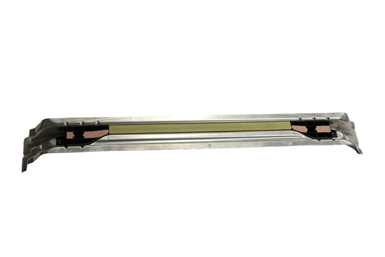BASF, L&L Products collaborate on battery protection for the 2022 Ford F-150 Lightning
Continuous Composites Systems and polyurethane pultrusion system reduces crossmember size while providing strength, stiffness and rigidity to withstand high loads.

The 2022 Ford F-150 Lightning. Photo Credit, all images: BASF Corp.
BASF (Wyandotte, Mich., U.S.) and L&L Products (Romeo, Mich., U.S.) have developed a battery protection solution for the This vehicle is the first all-electric F-Series truck from Ford Motor Co. (Dearborn, Mich., U.S.) and deliveries begin this spring 2022.
The team reportedly reduced the size of the crossmember that is part of the battery system without compromising strength. The crossmember is a structural section designed to withstand high loads, keeping both the battery and occupant safe in the vehicle.
“We were able to use a solution featuring L&L’s Products’ Continuous Composites Systems (CCS) and BASF’s Elastocoat 74850 polyurethane system that eliminated the need for extensive redesign of the crossmember while providing strength, stiffness and rigidity to a lightweight structure,” Chris Korson, chassis market segment manager, Performance Materials, BASF Corp., says.

Fiber-reinforced pultruded crossmember.
CCS combines a fiber-reinforced pultruded composite carrier with highly engineered sealants and adhesives in a 2D profile. This continuous process creates straight or curved composite profiles reinforced with continuous fibers and mats.
“This innovation also shares three firsts for CCS,” Hank Richardson, product engineering manager, L&L Products, notes. “One being the first developed closed section tubular CCS part, the second being the first CCS body-in-white [BIW] application and the third being the first use of CCS in an electric vehicle [EV].”
The crossmember was also the first application for BASF’s Elastocoat 74850 polyurethane pultrusion system to be implemented prior to the E-Coat process. Additionally, a new computer simulation methodology was developed using BASF’s proprietary CAE modeling software, , to show the behavior of the pultruded structures and accurately capture the additional load after failure that a composite provides.
Related Content
-
Plant tour: Aernnova Composites, Toledo and Illescas, Spain
RTM and ATL/AFP high-rate production sites feature this composites and engineering leader’s continued push for excellence and innovation for future airframes.
-
The potential for thermoplastic composite nacelles
Collins Aerospace draws on global team, decades of experience to demonstrate large, curved AFP and welded structures for the next generation of aircraft.
-
Carbon fiber composite pallet revolutionizes freight industry
LOG Point Pallet fuses advanced materials with innovative design and manufacturing to improve supply chains worldwide.






